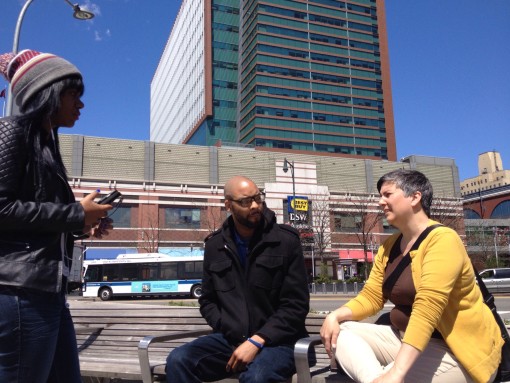Yesterday Keren and I sat in the sun outside the Barclays Center, the Nets arena in a busy corridor of Brooklyn. We positioned the “Please Talk With Me About Race” sign to face into the horseshoe of benches just outside the Barclays/Atlantic Avenue subway station.
As in the other places we’ve used the sign, it took about a half hour for anyone to come up to speak with us, but there was a lot of diverse foot traffic, so we had ample opportunity to observe body language of those going by. One 50-something white man was walking with

Talking with Donald and Crystal outside the Barclays Center in Brooklyn.
a 40-something white man in mid-level manager business attire. The younger man was talking and the older man read the sign as he walked, his mouth turning down in displeasure. A number of elderly African American women passed by, singly, but each of them nodded and smiled when they read the sign. Several people whom I pegged as Latino read the sign without expression or comment.
A couple of young black friends, a woman and a man maybe in their late teens or early 20s, ate their lunch and talked on a bench across the way. They looked up at the sign several times and were clearly commenting to each other about it, but their voices were out of my hearing until the young woman said sharply, “I don’t want to talk about fucking race.” She wasn’t directing her comment to me, but it wasn’t meant to miss me, either.
Eventually, an African American man approached with his female friend. “You know I’m not going to pass by that without asking some questions,” he said, laughing.
We introduced ourselves and I told them what we were doing. His name is Donald and his friend’s name is Crystal. They talked with us a long time about media representation of black protest and of the psychic burden created by the constant assaults on black people, by the knowledge, as Crystal noted, that a person can get a stiffer sentence for abusing a dog than killing a black person.
I asked how the state of race relations felt now compared to before the high-profile death of Eric Garner.
“It goes in waves,” Donald said. He spoke of the cycle of active protest and followed by feelings of helplessness. Overall, though, things aren’t better, Crystal and Donald agreed.
Donald said that the work that Keren and I are doing is like “shooting for the moon,” but he commended us for trying. I told him that I believe that to end racism we have to change the big systems and individual hearts and minds. “My work definitely won’t get us to the moon, but I’m building my own little part of the rocket,” I said.
In the middle of our conversation, a black man with the layered look of someone who sleeps on the streets, called out, “I’ll race you!” with a charming smile in our direction. His joke reminded me of something my dad would have said — a precisely timed pun meant to break the tension of the discussion at hand. But I didn’t sense any tension in that moment. I sensed despair.
“All you can do is pray,” Donald said toward the end of the conversation.
“That’s how life is,” Crystal said.
Although my assessment several days ago was that the majority — maybe two thirds — of the people who stopped to talk with us were white, I recalculated yesterday in Brooklyn as we waited for someone to approach us. In fact, it’s mostly people of color who are coming to talk.
Before this book tour, I knew from my own experience and from racial dialogue teachers that white people generally are not inherently interested in race. They often see themselves as lacking a race per se and having a neutral status. Conversations about race are something people of color are interested in, goes the white assumption, because they “have race” and white people “don’t have race.”
This belief structure was underscored for me the other day when I received an email from a friend back in rural Wisconsin. She wrote, on seeing a picture of me sitting next to the sign in Columbus, “It’s funny: Our stereotypes are so firmly in place — I found it startling to see that sign next to a white woman! Lots of room for growth, starting at home …”***
Good for her for noticing that, for the most part, white people have been programmed to think this work belongs to people of color. That’s a powerful first step. Notice that and then you have to begin your own work.
*** A note about me: During this tour/sign project, I decided that I was going to let people see me as whatever race they decided I was, unless identifying myself became significant to the conversation or somebody directly asked me. I identify as a mixed-race person, with white, Filipino, and Mexican ancestry.